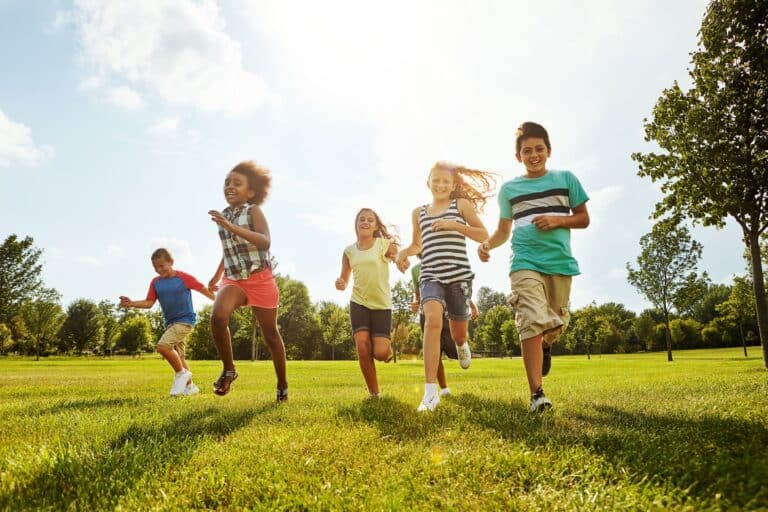Keeping students engaged is a daily goal that teachers are always trying to hit, and for good reason: it’s directly tied to how much students learn and retain. But let’s be honest, coming up with fresh and creative ways to hold their attention isn’t always easy.
If you’re looking for something new to try, one simple yet powerful strategy might surprise you: take your teaching outside. Simply stepping outside can make a noticeable difference in your students’ attention and energy levels.
Studies have shown that students learning outdoors return to the classroom more focused and ready to learn. Changing the scenery to something more natural, even just occasionally, has been shown to reduce stress, boost mood, and support better behavior and concentration.
So instead of trying to overhaul your entire teaching approach to make outdoor learning work, with a little planning and flexibility, you can incorporate outdoor teaching in a manageable and fun way. Here are some practical outdoor teaching strategies to help you maximize student learning both outside and back in the classroom.
Set Expectations Before You Step Outside
If you’ve ever taken your class outdoors before, then you know it’s not quite as simple as opening the door and heading out. Before anything else, take the time to lay down some clear expectations.
Discuss behavior boundaries, noise levels, and how to move safely and respectfully in an outdoor space. Let students know that outdoor learning is still learning, and it’s not just an extended recess.
Creating a quick routine or checklist for outdoor time, just like you would for any part of your school day, helps make the transition smoother. Whether it’s lining up calmly, grabbing clipboards, or reviewing the goal of the lesson, those small prep steps go a long way in keeping things structured.
Start with Short and Purposeful Activities
Short and intentional activities are your best friend when you’re just starting with outdoor teaching. Look for spots where students won’t be easily distracted, avoiding spaces right outside classroom windows or near busy roads. Even a quiet corner of the playground or schoolyard can work wonders.
Try beginning with a simple nature walk. You can turn it into a learning scavenger hunt where students look for specific types of leaves, insects, or textures. Give them clipboards or journals to record what they see, hear, feel, or smell.
These short excursions allow students to release energy, build curiosity, and engage their senses, all while laying the groundwork for deeper learning when they return inside.
Make the Most of Group Work
Learning outdoors naturally invites collaboration. When students are working together in an open space, they often feel less pressured and more creative. Small groups or partners are a great way to keep students accountable and safe, while also encouraging discussion and teamwork.
Assign roles within each group to help students stay focused. One student might be the recorder, another the materials manager, and another the timekeeper or observer.
These mini-roles keep students on task and ensure that everyone has a purpose. After the activity, students can regroup in the classroom to share their findings and reflect on the experience.
Strengthen Observation Skills with Nature-Based Tasks
Nature is one of the best teachers when it comes to building observation skills. Just by stepping outside, students have access to a living, breathing environment filled with details they may never notice indoors.
Whether it’s the color patterns of leaves, the buzz of insects, or the feeling of grass under their feet, there’s no shortage of sensory experiences to explore.
To make it structured, try creating an observation journal that students use every time they go outside. Each entry can focus on something different, like plant life, animal behavior, sounds in the environment, or weather changes.
You can also turn it into a sensory scavenger hunt: find something smooth, something rough, something that makes noise, something that smells strong. These types of activities get students thinking critically about their surroundings and using all five senses to investigate.
Connect Outdoor Learning to Indoor Learning
One of the most important parts of outdoor learning happens after you come back in. That’s where the magic of reflection comes in. Whether it’s through writing in a physical or virtual journal, doing a quick think-pair-share, or having a group discussion, giving students the chance to talk through what they saw, felt, and discovered helps deepen their understanding.
And since that post-outdoor window often comes with increased focus and calmness, it’s the perfect time to take the lesson further. For example, if students observed bugs during their nature walk, now’s your moment to introduce insect lifecycles or habitats.
If they found different types of leaves, tie them into a science unit on trees or plant classification. Those outdoor experiences become the “hook” that brings the next lesson to life.
Keep It Flexible and Take Advantage of Teachable Moments
One thing about outdoor learning is that you can plan it all out, but nature has its own schedule. Sometimes, a sudden gust of wind or a surprise animal may make an appearance and derail your plan. That’s okay. Outdoor learning works best when you’re open to the unexpected.
Use these moments as teaching tools. Maybe the wind will lead to a spontaneous mini-lesson on the weather. Maybe the bird that landed nearby sparks a class-wide curiosity about migration.
These teachable moments are what make outdoor learning so powerful because it’s authentic, real-world learning that taps into students’ natural curiosity.
The beauty of outdoor teaching lies in how well it supports the big picture of learning. It gets students moving, engages in their senses, builds collaboration, and helps them make real-world connections. But more importantly, it reminds students, and us that learning doesn’t have to be confined to four walls.
So, the next time your students feel squirrely, your lesson could use a little boost, or if you’re just ready to shake things up, consider stepping outside. With a little creativity and a flexible mindset, outdoor teaching can become one of the most powerful tools in your teacher toolbox.
Educators never stop learning; check out our available graduate degree programs to hone your skills and promote lifelong learning and academic excellence.




